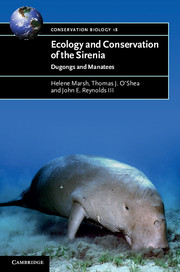Book contents
- Frontmatter
- Contents
- Foreword
- Preface
- Acknowledgements
- 1 Introduction
- 2 Steller’s sea cow
- 3 Affinities, origins and diversity of the Sirenia through time
- 4 Feeding biology
- 5 Behaviour and habitat use
- 6 Life history, reproductive biology and population dynamics
- 7 Threats
- 8 Conservation status
- 9 Conservation opportunities
- References
- List of online supplementary material
- Index
- Plate section
8 - Conservation status
Criteria, methods and an assessment of the extant species of Sirenia
Published online by Cambridge University Press: 05 January 2012
- Frontmatter
- Contents
- Foreword
- Preface
- Acknowledgements
- 1 Introduction
- 2 Steller’s sea cow
- 3 Affinities, origins and diversity of the Sirenia through time
- 4 Feeding biology
- 5 Behaviour and habitat use
- 6 Life history, reproductive biology and population dynamics
- 7 Threats
- 8 Conservation status
- 9 Conservation opportunities
- References
- List of online supplementary material
- Index
- Plate section
Summary
Understanding the conservation status of species is very important because it is an indicator of the likelihood of their continuing to exist. In this chapter we first review the criteria used for designating the conservation status of sirenians. We then provide an overview of the methods used for estimating abundance and trends in population sizes. The remainder of the chapter provides an updated summary of findings and our assessment of the status of the extant sirenians. This assessment includes reviews of their status under various international agreements, population sizes and trends, major threats and pertinent conservation impediments and actions.
Criteria for Designating Conservation Status
The IUCN Red List of Threatened Species (Red List) produced by the Species Survival Commission (SSC) of the International Union for Conservation of Nature (IUCN) is the best-known global conservation status listing and ranking system (IUCN 2009). In 2005 the World Conservation Congress passed a resolution mandating the use of the Red List for national legislation, international conventions, conservation planning and scientific research (IUCN 2005).
- Type
- Chapter
- Information
- Ecology and Conservation of the SireniaDugongs and Manatees, pp. 327 - 396Publisher: Cambridge University PressPrint publication year: 2011

